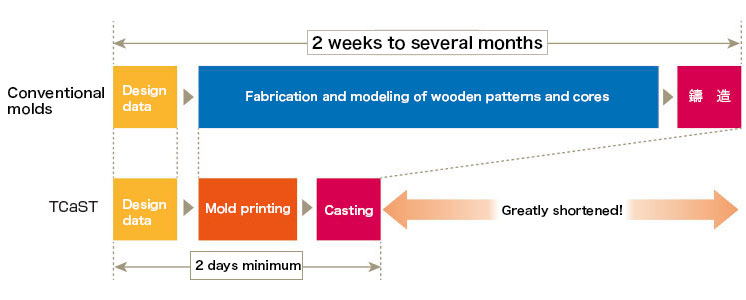 Effects of TCaST
Effects of TCaSTTCaST molds are printed directly from 3D data, without need for wooden patterns. This allows you to complete casting within two days, at the earliest, of the start of mold printing.

The smallest number of divisions will be enough for TCaST even for complex shapes which would otherwise require finely divided parts for a conventional wooden pattern. There is also no need of pattern drafts.
When minor change is made to the shape, it takes time and effort to modify a wooden pattern. With TCaST, you only have to modify the data.Change of the ingate shape, addition of gas vents or any other plan changes can be readily incorporated in the molds.
Data of molds are stored in electronic forms, which means no need to save space for storing molds.
There is no longer storage, maintenance or asset management for molds.
Impellers, which typically require numerous fine divisions for a wooden pattern, can be modeled with the smallest number of mold parts.
This shortens the lead time for casting a complex design.
You can easily make molds and cores with gas vents, which gives you castings with no gas defects.
Castings can have high precision as shown in the picture, without fine processing which is normally required for these products.
You can readily check shapes and functionality of the product at the stage of prototyping before mass production.
There is no need to prepare a wooden pattern for each prototype of different shape.
The nameplate was from a locomotive which was built more than 100 years ago. Since no drawings were left, we prepared 3D data by 3D scanning and printed the TCaST mold for casting the replica.
TCaST has many other applications than molds.
The architectural model is a printout created based on 3D data taken with drones.